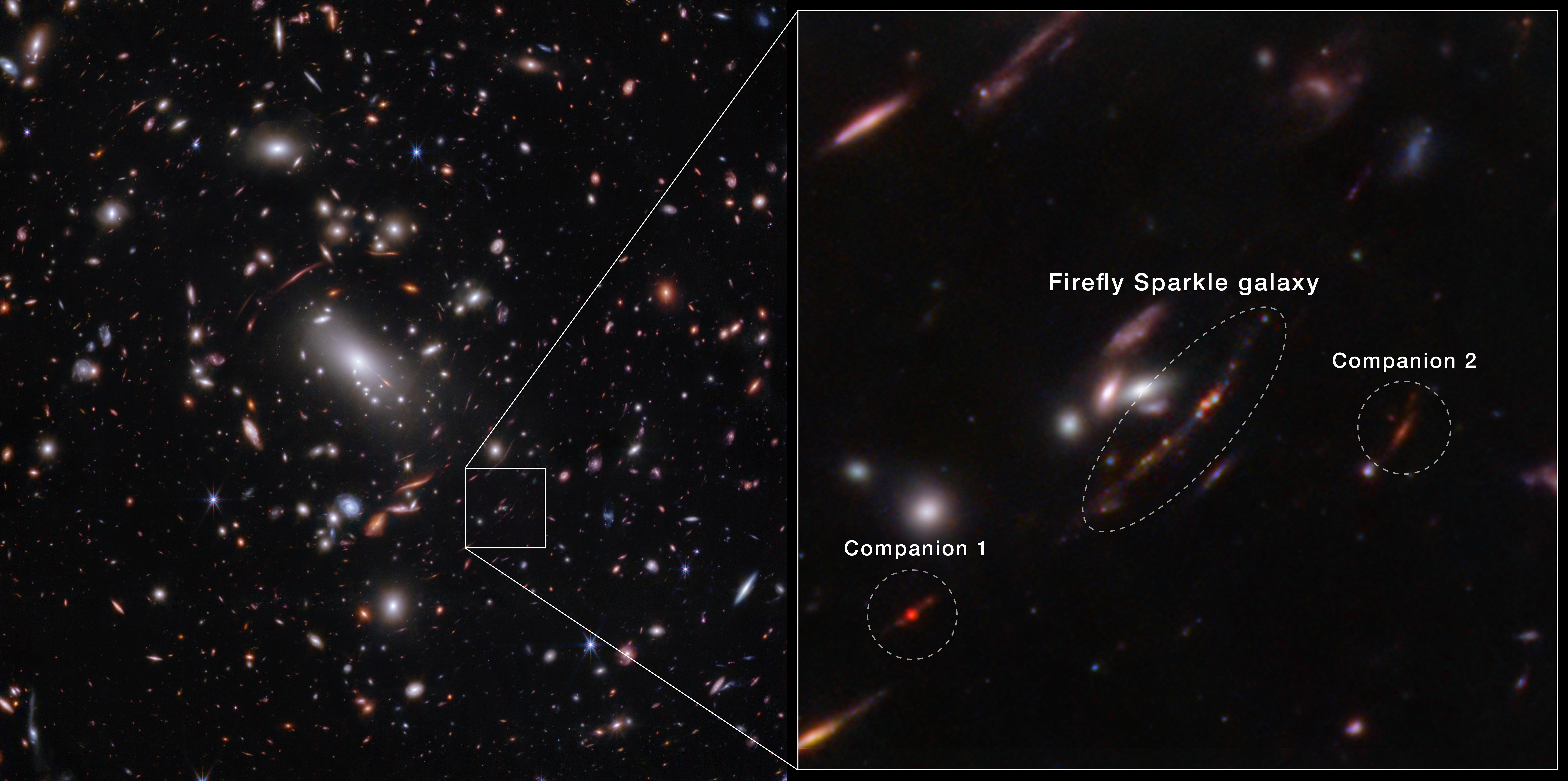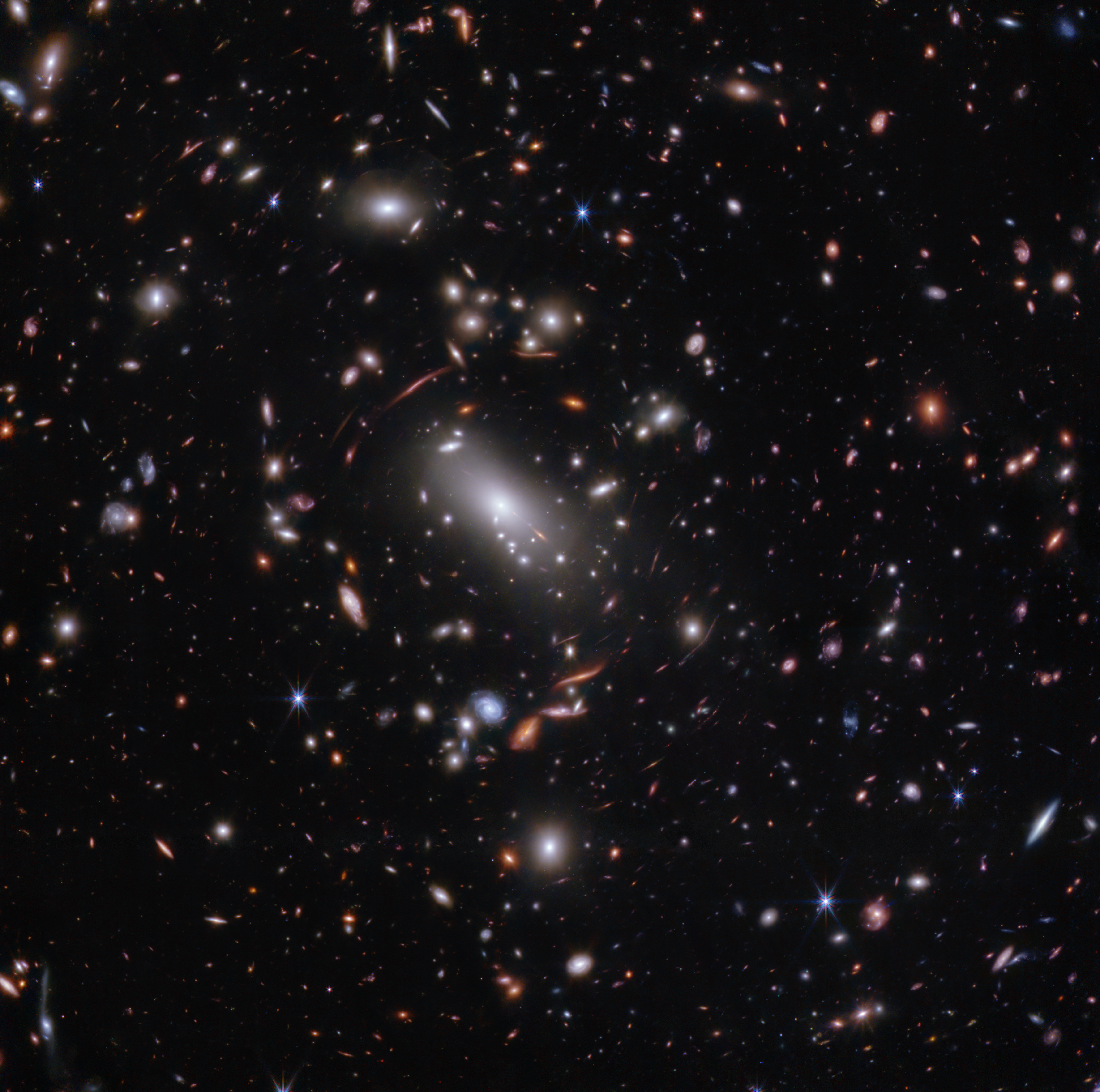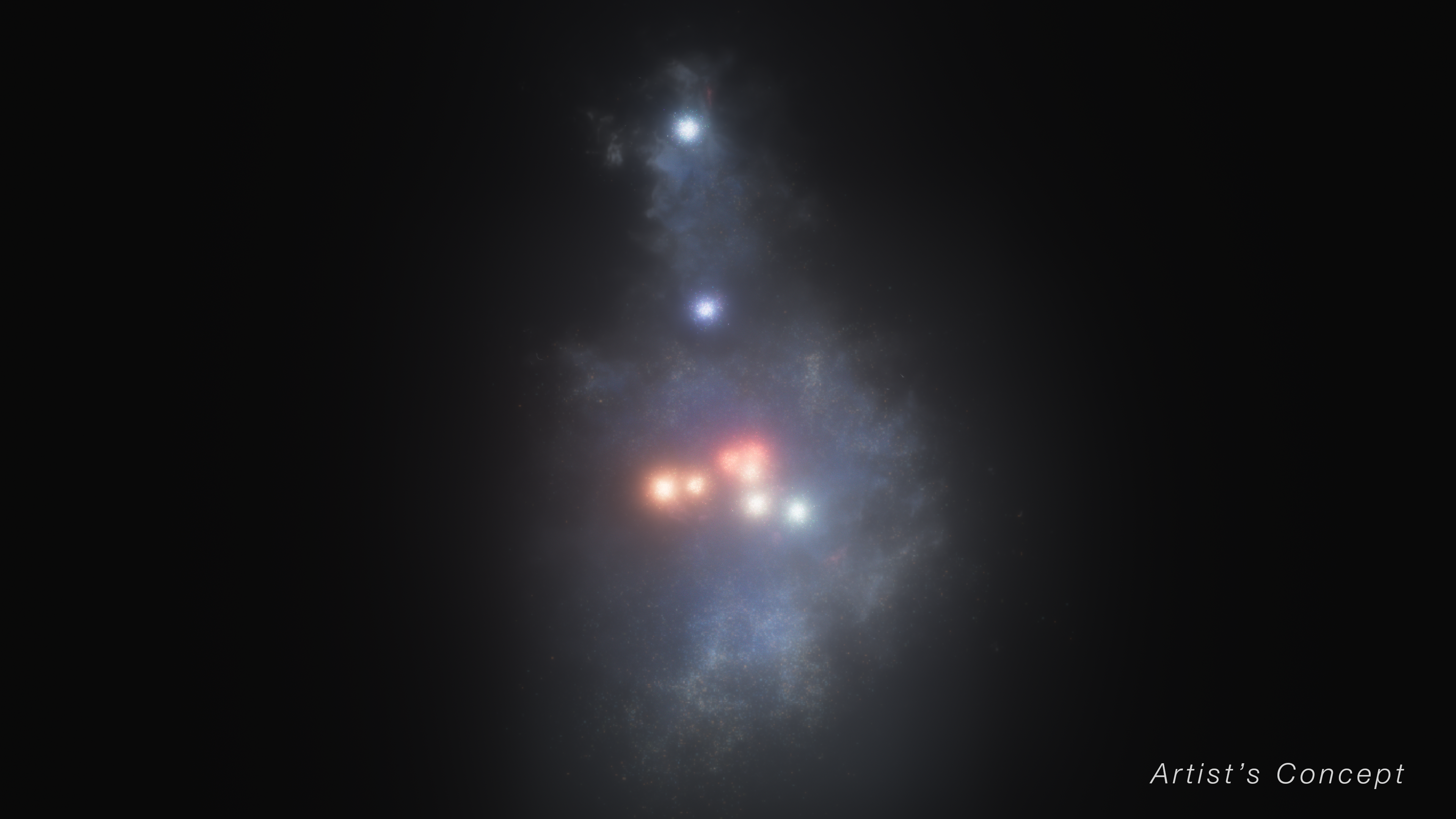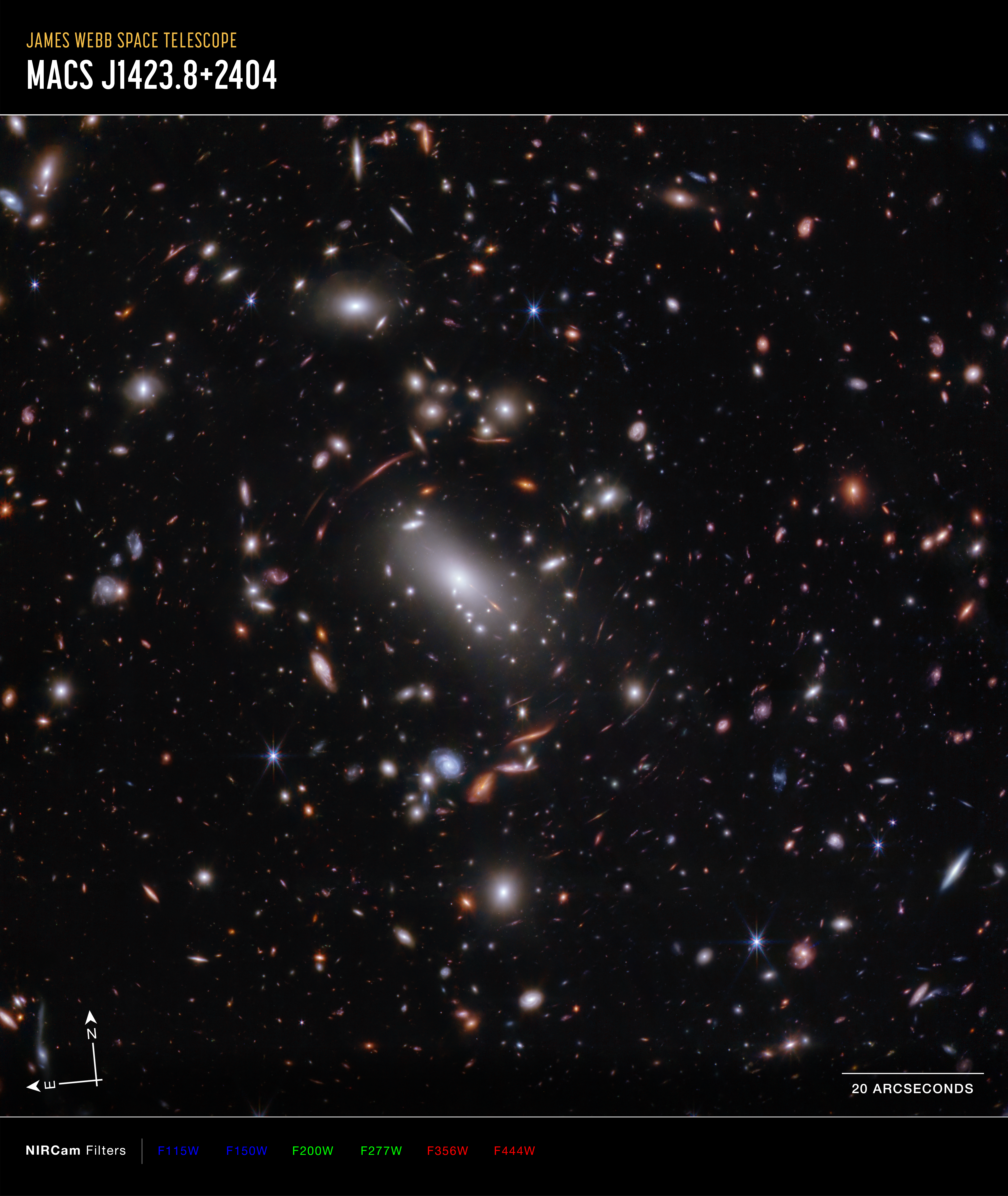1 min read
Firefly Sparkle Galaxy and Companions in Galaxy Cluster MACS J1423 (NIRCam Image)

For the first time, astronomers have identified a still-forming galaxy that weighs about the same as our Milky Way if we could “wind back the clock” to weigh our galaxy as it developed. The newly identified galaxy, the Firefly Sparkle, is in the process of assembling and forming stars, and existed about 600 million years after the big bang.
The galaxy is stretched and warped due to a natural effect known as gravitational lensing, which allowed researchers to glean far more information about its contents. (In some areas of Webb’s image, the galaxy is magnified over 40 times.)
While it took shape, the galaxy gleamed with star clusters in a range of infrared colors, which are scientifically meaningful. They indicate that the stars formed at different periods, not all at once.
“I didn’t think it would be possible to resolve a galaxy that existed so early in the universe into so many distinct components, let alone discover a Milky Way-mass galaxy in the process of forming,” said Lamiya Mowla, the lead author and an assistant professor at Wellesley College in Massachusetts.
Since the galaxy is stretched into a long line in Webb’s observations, the researchers were able to identify 10 distinct star clusters and study them individually, along with the cocoon of diffuse light from the additional, unresolved stars surrounding them. That’s not always possible for distant galaxies that aren’t lensed. Instead, in many cases researchers can only draw conclusions that apply to an entire galaxy. “Most of the other galaxies Webb has shown us aren’t magnified or stretched and we are not able to see the ‘building blocks’ separately. With Firefly Sparkle, we are witnessing a galaxy being assembled brick by brick,” Mowla explained.
There are two companion galaxies “hovering” close by, which may ultimately affect how this galaxy forms and builds mass over billions of years. Firefly Sparkle is only about 6,500 light-years away from its first companion, and 42,000 light-years from its second companion. Let’s compare these stats to objects that are closer to home: The Sun is about 26,000 light-years from the center of our Milky Way galaxy, and the Milky Way is about 100,000 light-years across. Not only are these companions very close, the researchers also project that they are orbiting one another.
Each time one galaxy interacts with another, gas compresses, allowing new stars to form in clumps. “It has long been predicted that galaxies in the early universe form through successive interactions and mergers with other, tinier galaxies,” explained Yoshihisa Asada, a co-author and doctoral student at Kyoto University in Japan. “We might be witnessing this process in action.”
This trio of galaxies exists in the galaxy cluster MACS J1423, which was observed by the Hubble Space Telescope in its Cluster Lensing And Supernova survey with Hubble (CLASH) program. Hubble was the first to image this galaxy, now known as the Firefly Sparkle. Webb was able to resolve seven additional star clusters, the light emitted by stars outside the clusters, and identify two companion galaxies, which enhanced the team’s research.
Mowla picked out the Firefly Sparkle galaxy while closely examining Webb’s CAnadian NIRISS Unbiased Cluster Survey (CANUCS), which includes near-infrared images from NIRCam (Near-Infrared Camera) and spectra from the microshutter array aboard NIRSpec (Near-Infrared Spectrograph). She was drawn to its gleaming star clusters, because sparkly objects typically indicate things that are extremely clumpy and complicated. Since the galaxy looks like a “sparkle” or swarm of lightning bugs on a warm summer night, the team nicknamed it the Firefly Sparkle galaxy.
Extended Description and Image Alt Text
Extended Description
This horizontal image is split down the middle. At left is a galaxy cluster showing thousands of overlapping objects at various distances spread across this field. The background of space is black. The galaxies’ colors vary. The majority appear white or pink, some are shades of orange or blue. Most galaxies appear as fuzzy ovals, but a few have distinctive spiral arms. The most distant galaxies are the tiniest and appear as red dots or smudges. Several foreground stars with eight diffraction spikes appear as large as some of the smaller galaxies. Just above center is a very bright white, oversized oval, which is angled at 45 degrees, pointing to the top left and bottom right. This is a supergiant elliptical galaxy. Immediately around it are many thin, long, orange or pink arcs. They follow invisible concentric circles that curve around the center. These are background galaxies that have been stretched and distorted.
To the bottom right of this supergiant elliptical galaxy is the white outline of a small box. On the right side is a zoomed in view of this area. There are two smaller dotted circles flanking a larger dotted oval at the center.
The central oval is labeled Firefly Sparkle galaxy. Within it appears a discontinuous, long line that roughly points from bottom left to top right. The Firefly Sparkle galaxy is a gravitationally lensed galaxy. It contains 10 circular clusters of stars that are largely pink and purple toward the bottom left, with some larger circles that have blue centers toward the top. There are hazy, semi-transparent pink dots toward the top right with some hazy blue. Most of these star clusters appear joined by a faint, light blue line.
The galaxy to the bottom left is labeled Companion 1 and looks like a bright red dot, slightly larger and brighter than most in the Firefly Sparkle galaxy, with at least two far hazier, semi-transparent red dots to its left and right.
To the right, Companion 2 is lighter red overall, with the darkest area at the center forming a tiny oval, and a red disk extending on its left and right, giving it the appearance of an edge-on galaxy. Smaller hazy red dots appear to the top center and top right.
In the background, several dozen hazy galaxies appear in a range of sizes and shapes, most appearing far larger than the circled objects. They are light pink, dark pink, orange, and diffuse blue, and take on the shapes of circles and ovals.
Image Alt Text
Horizontal split down the middle. At left, thousands of overlapping objects at various distances are spread across this galaxy cluster. A box at bottom right is enlarged on the right half. A central oval identifies the Firefly Sparkle galaxy, a line with 10 dots in various colors.
About the Object
- R.A. PositionR.A. PositionRight ascension – analogous to longitude – is one component of an object's position.14:23:47.79
- Dec. PositionDec. PositionDeclination – analogous to latitude – is one component of an object's position.24:05:4.64
- ConstellationConstellationOne of 88 recognized regions of the celestial sphere in which the object appears.Boötes
- DistanceDistanceThe physical distance from Earth to the astronomical object. Distances within our solar system are usually measured in Astronomical Units (AU). Distances between stars are usually measured in light-years. Interstellar distances can also be measured in parsecs.Galaxy cluster is 5 billion light-years away
- DimensionsDimensionsThe physical size of the object or the apparent angle it subtends on the sky.Image is about 2.3 arcminutes across
About the Data
- Data DescriptionData DescriptionProposal: A description of the observations, their scientific justification, and the links to the data available in the science archive.
Science Team: The astronomers who planned the observations and analyzed the data. "PI" refers to the Principal Investigator.This image was created from Webb data from proposal: 1208 (C. J. Willott). Image processing: Alyssa Pagan (STScI).
- InstrumentInstrumentThe science instrument used to produce the data.NIRCam
- Exposure DatesExposure DatesThe date(s) that the telescope made its observations and the total exposure time.26 Feb 2023
- FiltersFiltersThe camera filters that were used in the science observations.F115W, F150W, F200W, F277W, F356W, F444W
- Object NameObject NameA name or catalog number that astronomers use to identify an astronomical object.Firefly Sparkle, MACS J1423.8+2404
- Object DescriptionObject DescriptionThe type of astronomical object.Lensed galaxy, galaxy cluster
- Release DateDecember 11, 2024
- Science ReleaseFound: First Actively Forming Galaxy as Lightweight as Young Milky Way
- CreditImage: NASA, ESA, CSA, STScI, Christopher Willott (NRC-Canada), Lamiya Mowla (Wellesley College), Kartheik Iyer (Columbia)

This image is a composite of separate exposures acquired by the James Webb Space Telescope using the NIRCam instrument. Several filters were used to sample wide wavelength ranges. The color results from assigning different hues (colors) to each monochromatic (grayscale) image associated with an individual filter. In this case, the assigned colors are: Blue: F115W + F150W, Green: F200W + F277W, Red: F356W + F444W
Related Images & Videos

Galaxy Cluster MACS J1423 (NIRCam Image)
Thousands of glimmering galaxies are bound together by their own gravity, making up a massive cluster formally classified as MACS J1423. The largest bright white oval is a supergiant elliptical galaxy and the dominant member of this galaxy cluster. The galaxy cluster acts like a...

Illustration of the Firefly Sparkle Galaxy in the Early Universe (Artist's Concept)
This illustration depicts a reconstruction of what the Firefly Sparkle galaxy looked like about 600 million years after the big bang if it wasn’t stretched and distorted by a natural effect known as gravitational lensing . This concept is based on images and data from NASA’s...

Galaxy Cluster MACS J1423 (NIRCam Compass Image)
This image of galaxy cluster MACS J1423, captured by the James Webb Space Telescope’s NIRCam (Near-Infrared Camera), shows compass arrows, scale bar, and color key for reference. The north and east compass arrows show the orientation of the image on the sky. The scale bar is...
Share
Details
Laura Betz
NASA’s Goddard Space Flight Center
Greenbelt, Maryland
laura.e.betz@nasa.gov
NASA, ESA, CSA, STScI, Christopher Willott (NRC-Canada), Lamiya Mowla (Wellesley College), Kartheik Iyer (Columbia)































